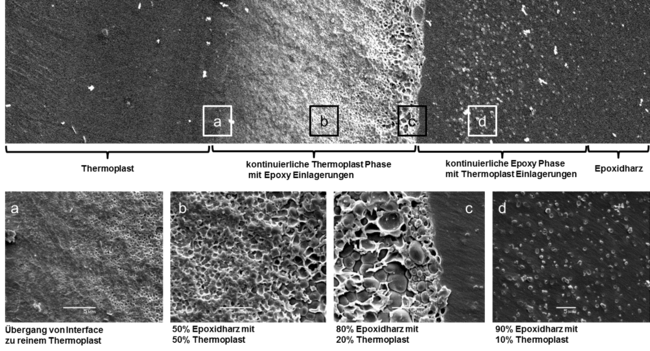MAI Fo – Development of a Process Chain for the Production of Foiled Fiber Composite Structures
Three dimensional fiber composite structures with intelligent surface – economically feasible?
Project Partners
Airbus Helicopters Deutschland GmbH, BMW AG, BASF SE
Duration
01.05.2013 – 30.04.2016
Funding authority
German Federal Ministry of Education and Research
Motivation
In order to successfully integrate new fiber composite structures into the manufacturing process chain of the automotive and aviation sector, low material and production costs are necessary. However, when the new materials are equipped with additional functions, a further value besides structural performance can be created that significantly increases the attractivity of fiber composite structures. The project MAI Fo explicitly adressed synergies that can be created by the combination of foils and fiber reinforced plastics. Central point was the development of a process chain for the production of three dimensional fiber composite parts with their surface partly or fully covered with a foil.

Method
A process was developed in which the dry fiber preforms were packed and sealed in foil. The foil is subsequently pressed onto the preform. A suitable conpect for the impregnation of the packed preforms with resin was explored. Moreover, a method of locally introducing foils in the production process was developed. Special feature of foils at the surface of a component is the possibility to integrate functions into the process as well as into the fiber reinficed structure. Due to the direct bonding of the foil during curing of the resin, the effort in the usual later surface treatment can significantly be reduced. The integration of the foil into the process leads to a reduction of process steps or to a reduction of auxilliary materials. For instance, an ease of handling of dry fiber preforms and the realization of a vacuum bagging can be achieved at once due to the multi-functionality of a foil. Hereby, the foil can serve as a support, as a sealant and as a functioalization of the part surface (e.g. for a subsequent painting process). In the ideal case, no surface finishing work is required any more. By means of a foil, the part can also be equipped with specific properties, namely scratch resistance, flame protection and UV protection. Overarching goal is ultimately a cost reduction in part production to increase competitiveness of leading German companies.
Publications
Bruckbauer, P.; Beier, U.; Drechsler, K.: Polyetherimid-Epoxidharz Interphasen zur Anbindung von Funktionsschichten auf Faserverbundwerkstoffen. Journal of Plastics Technology 14, 2018
Bruckbauer, P.; Weiland, F.; Beier, U.; Drechsler, K.: Characterization of thermoplastic/thermoset combinations - potential application for joining. SAMPE Europe Conference 15 Amiens, 2015
Acknowledgement
The chair thankfully acknowledges the funding of the project “Entwicklung einer Prozesskette zur Herstellung von teilfolierten Faserverbundbauteilen – MAI Fo” provided by the German Federal Ministry of Education and Research under the leading edge cluster MAI Carbon (funding code: 03MAI08D).



Contact Persons
Dipl.-Ing. Kalle Kind; Dr.-Ing. Swen Zaremba
Final Report
External link (pdf)